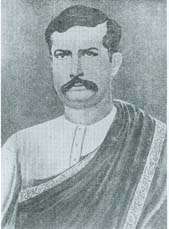Sanjib Chandra Chattopadhyay
| Sanjib Chandra Chattopadhyay | |
|---|---|
 Sanjib Chandra Chattopadhyay | |
| Born |
27 June 1838 Naihati, Bengal, India |
| Died |
8 April 1899 (aged 60) Kolkata, Bengal, India |
| Occupation | Magistrate, writer, lecturer |
| Nationality | Indian |
| Alma mater | University of Calcutta |
| Genre | Poet, novelist, essayist, journalist |
| Subject | Literature |
| Literary movement | Bengal Renaissance |
| Notable works | Author of Palamou & Bengal Ryots: Their Rights and Liabilities |
Sanjib Chandra Chattopadhyay (Bengali: সঞ্জীবচন্দ্র চট্টোপাধ্যায় Sanjeeb Chôndro Chôţţopaddhae)[1] (1834[2] – 1889)[2] was a Bengali writer, poet and journalist.[3] He was the elder brother of Bankim Chandra Chattopadhyay
Sanjib Chandra was born to an orthodox Brahmin family at Kanthalpara, North 24 Parganas. He was educated at Hooghly Mohsin College founded by Bengali philanthropist Muhammad Mohsin and Presidency College, Calcutta. He was one of the first graduates of the University of Calcutta.
Sanjib Chandra is widely regarded as a key figure in literary renaissance of Bengal as well as India.[3] Some of his writings, including novels, essays and commentaries, were a breakaway from traditional verse-oriented Indian writings, and provided an inspiration for authors across India.[3]
Early life and background
Bankim Chandra was born in the village Kanthalpara in the town of North 24 Parganas, Near Naihati,in an orthodox Bengali Brahmin family, the youngest of three brothers, to Yadav (or Jadab) Chandra Chattopadhyaya and Durgadebi. His family was orthodox, and his father, a government official who went on to become the Deputy Collector of Midnapur. One of his brothers, Sanjeeb Chandra Chattopadhyay, was also a novelist and his known for his famous book "Palamau".
He was educated at the Hooghly Mohsin College founded by philanthropist Muhammad Mohsin and later at the Presidency College, graduating with a degree in Arts [Law] in 1857. He was among the early graduates of the University of Calcutta.[4] He later obtained a degree in Law as well, in 1869.
He was appointed as Deputy Collector, just like his father, of Jessore, Chattopadhyay went on to become a Deputy Magistrate, retiring from government service in 1891. His years at work were peppered with incidents that brought him into conflict with the ruling British. However, he was made a Companion, Order of the Indian Empire in 1894.
Literary career
Bangadarshan was published by his editorial ship.
Palamou - A travel literature,considered as a classic .
Bengal Ryots : Their Rights and Liabilities[5]
References
- ↑ (Chattopadhyay in the original Bengali; Chattopadhyay or Chatterji as spelt by the British)
- 1 2 Samsad Bangali Charitabhidhan Archived 2016-04-10 at the Wayback Machine.
- 1 2 3 Staff writer. "Sanjib Chandra: The First Prominent Bengali Novelist", The Daily Star, 30 June 2011
- ↑ Islam, Sirajul (2012). "Chattopadhyay, Sanjeeb Chunder". In Islam, Sirajul; Jamal, Ahmed A. Banglapedia: National Encyclopedia of Bangladesh (Second ed.). Asiatic Society of Bangladesh.
- ↑ "Bengal Ryots: Their Rights and Liabilities : Being an Elementary Treatise on the Law of Landlord and Tenant". Google Books. Retrieved 27 February 2017.
Further reading
- Ujjal Kumar Majumdar: Bankim Chandra Chattopadhyay: His Contribution to Indian Life and Culture. Calcutta : The Asiatic Society, 2000. ISBN 81-7236-098-3.
- Walter Ruben: Indische Romane. Eine ideologische Untersuchung. Vol. 1: Einige Romane Bankim Chattopadhyays iund Ranbindranath Tagore. Berlin: Akademie Verlag, 1964. (German)
- Bhabatosh Chatterjee, Editor : Bankimchandra Chatterjee : Essays in Perspective (Sahitya Akademi, New Delhi) 1994.